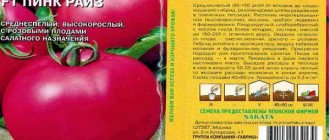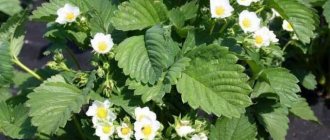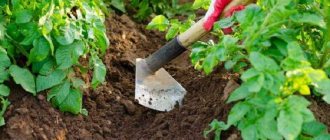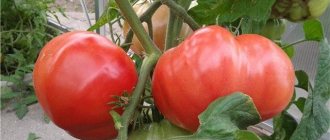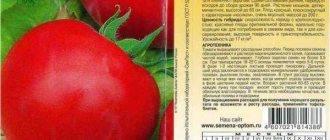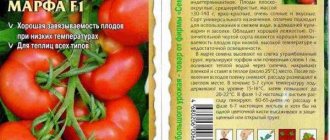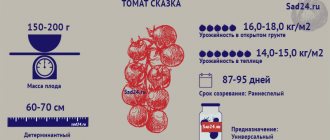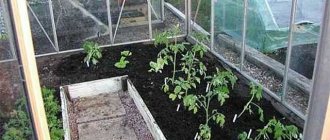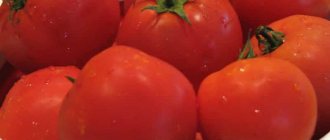Tomato Juggler F1 is a real find for those who have a garden in Siberia or the Far East. The new hybrid is intended for planting not only in greenhouses, but also in open areas. Unfavorable conditions are not scary for him.
| Height | Landing location | Ripening time | Fruit color | Fruit size | Origin | Fruit shape |
| Medium height | Greenhouse, Open ground | Early ripening | Reds | Average | Hybrid | Flat-round |
Description of the variety
Juggler F1 is an early-ripening, high-yielding hybrid of the first generation, the first fruits of which can be harvested 90-95 days after the appearance of mass shoots. The variety was bred by Russian breeders and appeared in the State Register in 2008. It can be grown in open ground even in the Far East and Siberia. We will consider the main characteristics of the plant and fruit separately.
Bushes
According to the type of growth, the plant with few leaves is determinant. When grown in open ground, the height of the bushes reaches 60-70 cm, and in a greenhouse - 100-110 cm. The leaves are ordinary, have a dark green color, medium dissection and slight corrugation.
Inflorescence of the usual type. The first of them appears above the 5th or 6th sheet, and the subsequent ones appear after 1-2 sheets. About 5-8 fruits can ripen on one cluster at the same time. As a rule, about 30 tomatoes grow on one plant, and ripening is consistent.
Fruit
They have the following characteristics:
- Weight . The average is 250 g, but when grown in open ground it can reach 300 g, and in a greenhouse - 400 g.
- Form . Tomatoes with thick skin have a rounded, flat shape with slight ribbing at the stalk.
- Color . As the fruit ripens, it changes from green to deep red, without spots.
- Pulp . Moderately dense, fleshy and juicy pulp with 4-5 seed chambers, dry matter content up to 4% and sugars up to 2.3%.
- Taste . Sweetish taste with slight sourness, without wateriness.
Tomatoes of the hybrid variety Juggler are heat-resistant, have good keeping quality and transportability.
Characteristics table
Tomato Juggler F1 is very popular among other hybrids due to its characteristics. They are given in the following table:
| Parameter | Description |
| general description | Hybrid, early ripening, determinate variety |
| Originator | Russia |
| Ripening period | 90-95 days after germination |
| Productivity | In open ground - 13-16 kg per 1 sq. m, and in a greenhouse - 22-24 kg per 1 sq. m |
| Disease resistance | High, but the plant needs preventive treatment. It is not afraid of late blight because it is an early ripening variety. |
| Purpose | The variety is universal. The fruits can be eaten fresh, used for preservation and processing, since they do not crack when exposed to high temperatures. Meanwhile, tomatoes are sometimes unsuitable for canning as a whole due to their large size. Can be grown for sale. |
In the following video you can see what the Juggler bushes look like with powerful unripe fruits:
Features of cultivation
The tomato variety “Juggler” was bred by Russian breeders. Zoned for the Siberian and Far Eastern districts, recommended for cultivation in open ground and film shelters. Plants tolerate slight drops in temperature and drought.
The collected fruits are well stored and can be transported. Tomatoes can be harvested at the stage of technical ripeness; they ripen quickly at room temperature.
Important: Tomatoes of the “Juggler” variety can be grown in seedlings or without seedlings.
The seeds are soaked in a growth stimulant and sown in light nutrient soil based on humus. For germination, a temperature of at least 25 degrees is required. The emerging sprouts are watered with warm water from a watering can, and after the first true leaves appear, they are planted in separate pots. Before planting in a permanent place, young tomatoes are fed with liquid complex fertilizer.
With the seedless method, the seeds are sown directly into the soil, previously fertilized with a generous portion of humus. The plantings are sprayed with water and covered with film. Grown tomatoes are fertilized with a nitrogen-based mineral complex. In the future, 3-4 more feedings will be required. For better development, it is recommended to alternate mineral and organic fertilizers. Spraying with an aqueous solution of superphosphate is also useful.
Fertilizers and properly selected soil play a very important role in growing tomatoes. Read articles on this topic, as well as everything about basic agricultural practices for tomatoes:
- Types of soil for tomatoes, as well as how to create a soil mixture yourself and which soil is most suitable for planting tomatoes in a greenhouse.
- Phosphorus, complex and ready-made fertilizers, TOP of the best.
- How to feed plants with yeast, iodine, ash, hydrogen peroxide, ammonia, boric acid.
- Foliar feeding, when picking, for seedlings.
- Watering, pinching, tying, mulching.
Agricultural technology
To get a good harvest of Juggler, you should remember a few basic rules:
- You need to sow seeds for seedlings no earlier than the second half of April or 55-60 days before the intended planting in a permanent place. As a rule, seedlings are transplanted into open ground after June 10. Planting pattern – 50x30(40) cm.
- Tomatoes cannot be grown on clayey, heavy loamy and acidic soils with a pH value below 5. A suitable option is loose and light soil saturated with humus.
- The selected substrate should not contain excess manure, as it will provoke increased growth of green mass, which will cause the ovaries and future fruits to lag behind in development.
- Regardless of the method of growing tomatoes (through seedlings or direct sowing in open ground), it is undesirable to use a substrate on which other varieties of tomatoes, potatoes, peppers or peas were grown last year. The fact is that such soil often contains pathogens of various diseases, which can pose a danger to the Juggler.
- In temperate or cold climates, tomatoes should be grown through seedlings, as this will speed up the harvesting process. The fact is that while the young seedlings are growing and strengthening at home, the soil on the site will have time to warm up well.
- After planting, it is necessary to organize proper care of the seedlings, which includes their timely watering, fertilizing with mineral fertilizers, pinching, as well as preventive treatment against pests and diseases.
Compliance with all the rules of agricultural technology will allow you to get the maximum yield - up to 16-24 kg of fruits per 1 square meter. m of landing area.
The most productive varieties of tomatoes for polycarbonate greenhouses
The yield of tomatoes largely depends on the choice of variety. There are varieties developed specifically for high yields. However, even they need proper planting and care.
It is important to understand that seedlings should not be planted too close to each other or too far apart. A close distance will not allow the bushes to grow, but too large - on the contrary, which will affect their yield.
Any variety of tomatoes needs proper care. Plants require proper watering and feeding. The plant care plan can be found on the Internet on specialized websites.
Regardless of the variety, tomatoes need proper care
Many of these varieties are resistant to dry climates. It is important to ensure that tall bushes receive support, as their weight can simply break them. The shape and color of tomatoes differs depending on their variety.
Planting through seedlings
In this case, you can use one of two methods - purchase ready-made seedlings or grow them yourself. Each method requires separate consideration.
You can get useful tips on how to grow tomato seedlings in the following article.
Purchase
If you lack experience or do not want to grow seedlings yourself, you can purchase them from trusted places. In this case, you should pay attention to the following parameters:
- State of green mass . Seedlings should not have too thick a trunk or huge leaves. Although they look attractive, they will not produce good ovaries, but painful tops will grow throughout the entire area. As a rule, such seedlings are overfed with nitrogen fertilizers. Of course, the stems should also not be too long and thin, and the lower leaves should not be yellowed. Such seedlings simply cannot take root in the garden.
- Number of leaves . If the specimen is healthy and strong, then it should have at least 7 leaves. The lower ones must be intact, without yellowness or brown areas.
- Barrel size . Ideally, it should resemble a pencil, but it can be a little thicker.
- Root system . It should not be dry or have signs of putrefactive lesions.
- Placement . If the seller has literally filled boxes with seedlings, their root system is probably already damaged, so you should refrain from purchasing them. Of course, the roots can grow back, but this will take at least 1-2 weeks.
The purchase of seedlings must be approached with special attention, because even if there are several seedlings with putrefactive lesions or viral diseases, the entire stock may perish.
DIY preparation
Seeds should be planted for seedlings in early March. This process consists of the following steps:
- Selection of containers . Should be spacious and have drainage holes at the bottom. The boxes meet these requirements. Meanwhile, you can plant tomatoes for seedlings in separate small containers, which will avoid picking the plant.
- Seed preparation . To germinate seeds, planting material must be filled with slightly salted water, removed after 30 minutes, rinsed with clean water and dried. During soaking, a few seeds may float to the surface. They need to be removed, because they are unusable. There is another processing method - the day before planting, place the seeds in a damp paper napkin, which will ensure their quick hatching.
- Substrate preparation . It can be purchased at a garden store or prepared with your own hands by mixing humus, peat, turf soil and crushed tree leaves in equal parts. Add a glass of wood ash, 3 tbsp. to the finished mixture. l. superphosphate and 1 tbsp. l. potassium sulfate, and then mix everything thoroughly. In any case, the substrate must be disinfected - placed in the oven and heated for 20 minutes at high temperature.
- Planting seeds . The prepared soil should be poured into containers and lightly moistened with warm water. Deepen the seeds into the ground by 1 cm, leaving 2 cm between them, and cover them with fertile substrate or peat, but in a layer no thicker than 1 cm. If seedlings are grown in small containers, you can throw 2 seeds into each of them, so that in the future you can leave only the strongest sprout.
- Placement of seedlings . After planting, the soil should be covered with film and the containers should be placed in a warm place. When the first shoots appear, the film must be removed and the container placed on the windowsill. It should be taken into account that during the day the room temperature should be kept in the range of +23...+25°C, and at night it should not fall below +15°C. Seedlings should be warmed up with bright diffused light for 12-14 hours. If there is not enough light, you will have to use additional lamps.
- Watering . Seedlings need to be moistened as the top layer of soil dries. In this case, it is advisable to use a spray bottle and warm, settled water.
- Feeding . For active development, fertilizing must begin with seedlings. Seedlings can be sprayed with a solution of 1 g of ammonium nitrate and 1 g of superphosphate per 1 liter of clean water.
- Picking . With the appearance of 2-3 true leaves, the seedlings need to be pricked if the seeds were planted in one common box and not in separate cups. When picking, you should leave only strong and healthy shoots.
- Hardening . It is carried out 2-3 weeks before planting in a permanent place. Pots should be taken out to the balcony or outside every day, first for 1 hour, and then for 1.5-2. At the same time, it is necessary to reduce the frequency of watering and provide the sprouts with sufficient fresh air.
As soon as the seedlings get used to a little coolness, they can be transplanted into an open area.
Transplantation into the ground
50-55 days after the appearance of the first shoots, the seedlings can be transplanted to their permanent place at the rate of 4 sprouts per 1 square meter. m plot. In this case, you need to adhere to the following scheme:
- 3 days before planting, cut 3 lower leaves from the stems, leaving only small stumps to increase ventilation, protect against diseases and strengthen the fruiting cluster. After this, water the seedlings generously.
- The day before transplanting, dig holes in the garden bed, the size of which is slightly larger than the size of the seedling container. Pour 1 tbsp into them. l. superphosphate, and then fill it to the brim with water. When it is completely absorbed, repeat the action 3 more times.
- During planting, remove the seedlings, place them in separate holes and cover them with the remaining soil, and then water them generously.
The second watering after planting should be done a week later, and before that it is better to leave the seedlings alone.
Sustainable tomato varieties for a polycarbonate greenhouse: reviews
The choice of different varieties depends on what goals the gardener sets for himself and why he grows tomatoes. Everyone focuses on the quality of the fruit, but for some it is important, for example, their quantity, and for others the size, shape, color and taste. Reviews from gardeners will help you understand the varieties of tomatoes to grow in a greenhouse.
Many people praise varieties that are bred specifically so that the bushes produce large fruits.
The shape of the fruit depends on the variety. It can be round, oval, flat or convex. Tomatoes can have thick or thin skin and a fleshy or watery texture.
Tomato variety "Tanya F1" is resistant to various diseases
Reviews about tomato varieties:
- "Tanya F1". This variety produces juicy, tasty and sweet flat-shaped fruits.
- "Mazarin". The tomatoes are heart-shaped and crimson in color. They have a sweet taste and a small amount of seeds.
- "Rosemary F1". These fruits are very tender and sensitive. They must be torn off very carefully so as not to damage them.
- "Gilgal F1". Suitable for preservation and use in salads. They are quite large in size.
When choosing tomatoes, it is important to pay attention to variations in size and shape. Many varieties are quite demanding in terms of quality care, despite the fact that they can be resistant to many diseases, aridity and lack of light. It is important to monitor proper watering - the quality of the crop and the health of the bushes largely depend on this. The best varieties should be purchased not in markets, but in specialized stores. The manufacturer must be verified.
Planting seeds in open ground
When growing tomatoes in temperate climate zones with rather hot summers, the seeds should be planted in the ground in early May, when the soil is well warmed up and the likelihood of sudden frosts is minimized.
To get a good harvest, the soil should be prepared in the fall. It needs to be dug up with the addition of rotted manure or compost fertilizers. In the case of a greenhouse, it is advisable to replace 12 cm of the top soil layer. The new substrate must be fertilized with potassium salt and superphosphate at the rate of 40 g per 1 square meter. m.
The landing pattern looks like this:
- Soak the seeds in a special growth stimulator for a day or until small sprouts appear. An alternative is to wrap them in a damp, soft cloth for a day.
- Prepare shallow furrows in the area for seeding material. Their optimal depth is about 3 cm.
- Sow the seeds at a distance of 5 cm from each other. In the future, weak and excess shoots will be removed so that at least 40 cm remain between the grown and strengthened bushes.
- Seal the holes with the seeds and water them generously.
- Cover the bed with film, which is especially important for regions with a cool spring season.
To avoid mold, plantings should be regularly ventilated, especially in areas with slightly acidic or acidic soil.
Tomato hybrids for a polycarbonate greenhouse
The choice of tomato variety is influenced by many factors. When purchasing, it is important to pay attention to the region in which the greenhouse is located, since the quality of the harvest is affected by the number of sunny days and the abundance of daylight in the greenhouse. For seedlings in a greenhouse, gardeners often use hybrid varieties of tomatoes.
It is important to understand that hybrid varieties also differ from each other: some of them are more light-loving, others less.
Many hybrid varieties can be grown in a greenhouse year-round. To do this, the greenhouse must be well equipped. Every year, improved analogues of hybrids appear, which make it possible to obtain larger yields and healthy fruits.
Hybrid tomato varieties can be grown in a greenhouse all year round
The best hybrid varieties:
- "Evpator F1". This variety loves plenty of sunlight.
- "Mithridates F1". Has a generative type of development.
These tomato varieties can be grown in glazed greenhouses and hotbeds covered with film. The first inflorescences appear after the appearance of the tenth leaf. The leaves are small in size and dark green in color.
Maintenance and care
To get a good harvest, growing seedlings need to be well cared for. We will consider further what agricultural practices need to be carried out.
Watering
Juggler tolerates short-term drought well, but the seedlings should still be watered abundantly in the morning or evening, using water that has stood in the sun. Meanwhile, the intensity of watering needs to be adjusted depending on the stage of development of the seedlings. An approximate irrigation scheme looks like this:
- After planting seeds or seedlings, water the soil generously.
- Carry out the second watering on days 7-10.
- During the flowering period, water the plant every 4 days at the rate of 3 liters of water per 1 bush.
- During the period of formation of inflorescences and ovaries, water the plant once a week at the rate of 4 liters of water per 1 bush.
- With the appearance of fruits, water the plant 2 times a week at the rate of 2 liters of water per 1 bush.
When watering a tomato, it is worth considering that excess moisture is unacceptable, since it is a favorable environment for the spread of harmful fungi. However, it should also not be allowed to dry out, as this will lead to shedding of the ovaries, yellowing and curling of the tops. So, one should adhere to moderation, taking into account the condition of the top layer of soil.
Loosening, weeding
To ensure the full development of bushes, the soil must be regularly loosened and cleared of weeds. It is better to combine these two procedures and perform them after watering the soil. In this case, you need to act extremely carefully so as not to damage the root system of the plant.
In the case of young plants planted with seeds directly into the ground, weak and excess shoots should also be removed along with weeds.
Top dressing
The tomato is fed with organic matter and complex mineral fertilizers, which include the following preparations:
- Sudarushka;
- Master;
- Kemira;
- AgroMaster;
- Plantafol.
The interval between their application should be at least 15-20 days, so about 5 fertilizing can be done in one season. Their approximate diagram is as follows:
- If the seedlings have not been fed at home, 15 days after planting in a permanent place, the soil must be fertilized with a solution of mullein in a ratio of 1:10. Apply 1 liter of this solution to each bush.
- For the next feeding, use superphosphate and potassium salt. Each substance is taken 15 g and dissolved in water, which is poured under the root of the plants. Phosphorus will stimulate metabolic processes and strengthen the root system, and potassium will improve the taste of the fruit.
- During the next feeding, instead of the usual mineral fertilizers, you can use wood ash, incorporating it into the soil while loosening. There is another option - dissolve the substance in water at the rate of 200 g per 10 liters of water, let it sit for a day and pour it under the root of the plants.
When feeding tomatoes, excess nitrogen should not be allowed, as this will lead to excessive development of green mass and underdevelopment of the fruit.
Stepson and garter
The plant requires partial pinching, although the package with seeds may contain information that the hybrid variety is not pinching. To obtain a bountiful harvest, it is necessary to form a bush with 3 stems and remove all the stepsons that thicken the planting. The procedure should be carried out as needed, otherwise the sprouts will steal nutrients from the main shoots.
As for the garter, it should also not be neglected, although the variety is low-growing. The bushes can be tied with soft fabric tape to pegs driven into the ground, but it is better to install a trellis of several support bars and wire stretched between them.
Protection from diseases and pests
Juggler F1 is a hybrid variety, so it is not afraid of many diseases that pose a threat to nightshade crops. However, prevention should not be neglected. Meanwhile, it involves a number of simple manipulations:
- pre-treat the area with copper sulfate and potassium permanganate;
- as tomatoes grow, regularly loosen the soil and remove weeds to ensure filtration and prevent the development of root rot;
- To prevent late blight, treat the plant with Ordan and Fitosporin, but the latter of them must be used 20 days before the expected harvest.
When growing tomatoes in open ground, you must also remember about the possibility of it being damaged by various insects. Industrial insecticides can be used against them, with which the plantings need to be treated several times with an interval of 2-3 days. If the seedlings have attracted the attention of slugs, they can be scared away with ammonia.
Fungicides or insecticides must be used strictly in accordance with the instructions on the packaging, so as not to burn the tops or simply be left without a harvest.
Tomatoes for a polycarbonate greenhouse: the best varieties
Before planting tomatoes in a greenhouse, it is important to decide on the variety of tomatoes. Each variety is intended for a specific purpose: salad, preservation or long-term storage. Depending on this, plants have different characteristics and characteristics of growing in a greenhouse.
The quality of the harvest largely depends on the yield of tomatoes, climatic conditions in the region and temperature conditions in the greenhouse, and resistance to diseases.
When purchasing seeds for seedlings, it is important to pay attention to the purpose of planting tomatoes. Many varieties are simply not intended for planting in a greenhouse. Many people prefer hybrid varieties, as they are more resistant to temperature changes and various diseases.
You can grow several varieties of tomatoes in a greenhouse
Types of varieties for growing in a greenhouse:
- Ideterminate. Plants have unlimited growth. They can be grown in a greenhouse all year round. With proper care, these varieties give a large harvest. It is important to form the bush correctly - strictly into one stem. These are the following varieties: “De Borao red”, “Alexia F1”, “Hybrid Ivanhoe F1”, “Pink Lady F1”, “Demirosa F1”.
- Determinant. Plant growth is limited to the formation of four to five racemes. They are divided into simple determinant, semi-determinant and super-determinant. These are the following varieties: “Ural Multiple”, “Toyoto F1”, “Bobcat F1”, “Jane”. These varieties ripen quickly, allowing you to harvest them at the end of summer.
- Standard. Suitable for planting in both types of soil. Proper care ensures a bountiful and healthy harvest.
Choosing the best variety depends on the expectations and purposes for which the fruit is grown. The choice of variety is also influenced by expectations of fruit size. They can be large-fruited, medium-fruited and small-fruited.
Harvest and storage
When growing from seedlings, the first harvest can be harvested in mid-July, and from seeds - at the end of summer or early September. The collected fruits should be placed in empty boxes, immediately identifying and discarding rotting or cracked specimens.
You can keep the tomato in a dry basement at a temperature of +6°C. Thus, they can be stored all autumn until winter.
Advantages and disadvantages
Like any variety of tomatoes, “Juggler” has its advantages and disadvantages. So, let's start with the advantages, including:
- Advantages of the variety:
- High yield. From 1 sq.m. you can collect 6 kg of fruit.
- Resistance to the main diseases affecting tomatoes (stem necrosis, late blight, white rot, macrosporiosis, gray rot, powdery mildew, black leg, etc.).
- Good adaptation to any climate. Tolerance of low or very high temperature, .
- Moderately juicy and fleshy tomato , slightly sweet.
- Universal. Suitable for both salads and canning.
- Among the disadvantages it should be noted:
- The variety requires fertilizing and garter;
- Demanding about soil and regular watering.
Advantages and disadvantages
The juggler attracts gardeners with the following advantages:
- high yield with minimal care;
- good transportability and high shelf life;
- excellent taste;
- resistance to many diseases and insects;
- versatility in use;
- possibility of growing in regions with cool climates;
- ability to withstand sudden changes in temperature.
No disadvantages of the hybrid have been identified, however, errors in growing and caring for the plant can lead to a decrease in both the yield and the taste of the fruit.
Tomato Juggler is an early ripening variety that can withstand sudden temperature changes and changes in weather conditions. Gives a good harvest when grown in an area that is well lit by sunlight. Tomatoes have a universal purpose, so they can be eaten fresh or used for canning and processing into tomato products.
0
0
Copy link
Tomato seeds for a polycarbonate greenhouse: choice
Planting seeds must be of high quality, otherwise there is a risk that the plants will not even sprout. It is important to follow the purchasing rules that will help you avoid being scammed. You shouldn't buy tomatoes just because the seeds come in beautiful packaging.
When purchasing, it is important to pay attention to the characteristics and description of tomatoes, and not to the photograph placed on the package.
It is important to note that very often expectations from tomatoes diverge from reality. This is influenced not only by implausible pictures, but also by the conditions in which tomatoes are grown. To make a purchase, it is better to go to a specialized store rather than to the market, where there is a high probability of deception and fraud.
When buying seeds for planting, be sure to pay attention to the characteristics and description of the variety
Tips for choosing seeds:
- Do not buy seeds from unknown, unverified sellers.
- Trust only trusted manufacturers with a high reputation.
- Read the information on the packaging carefully.
Before purchasing, it is important to familiarize yourself with the intended variety, read more detailed information about it in reference books or on specialized websites on the Internet. It is strictly forbidden to buy expired goods, which is why you should carefully read the information on the packaging.
How to grow tomatoes
The seedlings are transplanted into the ground two months after sowing the seeds. By this time, at least four true leaves have formed on the bushes. The beds are chosen in a sunny place, protected from drafts.
Landing
The soil is prepared in advance : it is dug up and a full range of minerals is added. Make holes 15–20 cm deep and fill them with water.
Replant on a cloudy day or in the evening hours after sunset. This way the seedlings will take root and grow faster.
They are planted in the holes together with a lump of earth without disturbing the root system. After transplantation, the holes are compacted and watered with warm, settled water.
Further care for tomato Juggler f1
Regular watering is established as the seedlings take root in a new location. Water moderately, no more than twice a week. The peculiarity of this tomato is that it does not suffer from a long absence of watering, so it is not so bad not to water the plants as to flood them.
The root system suffers from excess moisture, and the seedlings begin to get sick. Water in the early morning or in the evening, but not in the scorching sun. To retain moisture in the beds, they are mulched with peat or straw.
Reference! Watering during the day can cause leaf burn.
After moistening, the soil is loosened and all weeds with roots are removed so that the nutrients are spent on the growth of seedlings and not on weeds. Many pests that are dangerous to tomatoes live in weeds.
Fertilizing is applied once every three weeks. During the season, seedlings are fertilized at least four times. The first fertilizing is applied two weeks after transplantation. Water with mullein infusion in a ratio of 1:15. The second is carried out at the time of flowering of the crop. They add a full range of minerals with a predominant content of phosphorus.
During the formation of ovaries, phosphorus and calcium are added, and at the time of fruiting, potassium salts are added to speed up the ripening of the fruit.
Features of cultivation and possible difficulties
The fruits of the Juggler hybrid are heavy; as they ripen, they can break the fruiting branches . Therefore, after transplantation, a support is installed next to each seedling, to which the branches are tied as they grow. The stem is also fixed, since it cannot withstand the weight of numerous fruit-bearing branches. The bush is formed into 3 stems, removing all other stepsons.
The lateral shoots of the stems thicken the plantings, so pinching is carried out regularly. The density of the bush can lead to the spread of fungal diseases.
Reference! The stepson is a side shoot that appears from the axils of the leaves and interferes with the full ripening of the fruit.
Diseases and pests
Summer residents report in their reviews that the vegetable crop practically does not get sick. This is a very convincing reason to grow a hybrid on your site. However, experienced gardeners do not forget about preventive measures, which include weeding, loosening and moderate watering. Treatment with Fitosporin not only protects plants from damage by fungal spores, but also improves immunity.
Farmer reviews
Gardeners speak positively about the Juggler f1 tomato and recommend planting it on your plots.
Mikhail, Perm: “I’ve been growing this hybrid for several years now. What is surprising is that it easily adapts to any climatic conditions, which cannot be said about other varieties. The harvest is always excellent, tasty, enough for fresh salads and numerous preparations. Canned tomatoes are delicious, just as good as fresh ones.”
Alla, Yekaterinburg: “I tried to plant tomatoes both in open ground and in a greenhouse. In the greenhouse, twice as many ovaries were formed. The fruits are like a picture, dazzlingly beautiful and tasty. These are my favorite tomatoes, and I strongly recommend them to every summer resident.”
How to grow seedlings
The hybrid can be grown in two ways: seedlings and without seedlings. When sowing seeds at home for seedlings, it is necessary to prepare the seed material.
Seed preparation
The seed material purchased from a specialized store is almost ready for planting: the manufacturer has already carried out disinfection and calibration. All that remains is to soak the seeds in a growth stimulator for 10 hours. This procedure will improve the germination percentage. The remedies are used not only by industrial production, but also by folk ones, and the latter are in no way inferior to biological stimulants.
Traditional methods include potato juice, aloe juice and melt water. Aloe juice additionally disinfects seed material, and potato juice enriches it with nutrients. Melt water is obtained from snow heated to room temperature.
Reference! Growth stimulants are organic substances that influence the growth and development of plants.
Preparing the container and soil
The soil for sowing seeds is prepared from a mixture of garden soil, humus and river sand in equal proportions. Disinfect the prepared soil in the oven at a temperature of 60 °C for 10 minutes or spill it with a hot solution of dark manganese. Disinfected soil will ensure healthy growth of young plants. You can also buy soil at the store. As a rule, purchased soil does not require disinfection or additional preparation.
Any container will do. You can plant both in a common and in a separate container. From the general container, a box is most often used, and plastic cups, paper honeycombs or peat pots are used as separate containers. When planting in separate containers, picking seedlings can be eliminated in the future.
Before sowing, the prepared containers are treated with a dark potassium permanganate solution for preventive purposes and small drainage holes are made at the bottom.
Sowing
The seeds are buried 1.5 cm, sprinkled with soil on top, lightly moistened with warm, settled water from a spray bottle and covered with film, artificially creating a greenhouse effect. The containers are left in a bright room at a temperature of +23–25 °C until germination.
Caring for seedlings
After sprouting, the containers are placed on the windowsill to provide the sprouts with sufficient light. If there is not enough daylight, the seedlings will stretch out and weaken, which will further retard their growth and development.
Reference! When daylight hours are short, additional lighting is installed using fluorescent lamps.
Water as the top layer of soil dries with warm, settled water from a shallow watering can or with a regular tablespoon. You cannot overwater the seedlings; the accumulation of excess moisture will cause rotting of the young roots. Also, with a large amount of moisture, the risk of developing a dangerous disease - blackleg - increases. The cause of blackleg is protobacteria of the genus Erwinia. The disease can destroy all plantings.
Reference! In the specialized literature, the term “blackleg” is not used, since it is the general name for a group of diseases with similar symptoms. Characterized by darkening of the stem at the very surface of the earth, it affects seedlings of vegetable and flower crops grown indoors or in greenhouses.
After watering, the soil is loosened to improve the air permeability of the soil. The flow of oxygen has a positive effect on the root system.
When two true leaves appear, pick them, placing them in separate containers. If the seedlings are left in a common container, then increase the distance between the seedlings, planting them no closer than 15 cm from each other.
Before transplanting into the ground, the bushes are hardened off in the open air, taking them outside for 40–50 minutes. Every day the stay time is increased by 30 minutes. Hardening is carried out for 10 days.
Plant pests and diseases
First generation hybrids are highly resistant to many diseases and pests. They are rarely affected by viruses, which is explained by their rapid maturation. But, nevertheless, in order to ensure high yields and protect the plant from diseases and pests, it is necessary to perform a number of preventive works:
- Before planting tomatoes, the area is treated with copper sulfate or potassium permanganate. For this, a special solution is made from these components.
- The bushes must be periodically sprayed with phytosporin and other drugs that have antifungal properties.
- Frequent weeding, loosening the soil and moderate watering will protect the plant from root and crown rot.
Read also: Commander for treating potato tubers against the Colorado potato beetle: instructions for use, reviews
In open ground, tomatoes are affected by various insects that can cause significant harm to the plants. To combat them, it is recommended to use industrial insecticides. The planting is processed several times, with an interval of 2-3 days. If plants are attacked by slugs, a solution of ammonia is widely used to remove them.
Tomato Juggler
Drought-resistant early variety
- Fact:
The variety grows well in unfavorable climatic conditions. Tolerates heat, drought and cold. - Fact 2:
The weight of tomatoes from unprotected soil reaches 300 g. The weight of tomatoes from a greenhouse is up to 400 g. - Fact 3:
“Juggler” does not require complex care and does not need to shape or tie the stem. - Fact 4:
If simple agricultural practices are followed, “Juggler” will begin to bear fruit in July. And it will delight you with a delicious harvest until September.
This is also interesting!
“Juggler” is a real find for summer residents. The variety grows well under unfavorable climatic conditions. Tolerates heat, drought and cold. Gives a good harvest. Tomatoes are universal in use. They can be stored for a long time and ripen at home without loss of taste.
